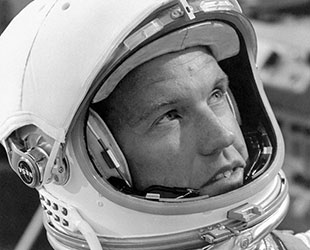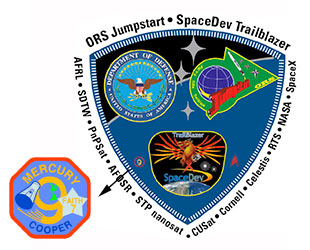May 22, 2012 — The cremated remains of one of NASA's original astronauts are now orbiting the Earth, having lifted off Tuesday (May 22) on board the same rocket that lofted a commercially-developed capsule that could, in the near future, carry the next astronauts to launch from U.S. soil.
The ashes of Mercury astronaut Gordon Cooper, who died in 2004, flew as part of a memorial payload organized by Celestis, a space services company based in Houston, on Space Exploration Technologies' — SpaceX's — Falcon 9 rocket.
The unmanned booster lifted off from Cape Canaveral Air Force Station's Launch Complex 40 in Florida at 3:44 a.m. EDT (0744 GMT).
Celestis' "New Frontier Flight" includes ash samples from more than 300 people, including Cooper and actor James Doohan, who was best known for his role as Montgomery "Scotty" Scott in the television and film series "Star Trek."

Gordon Cooper seen preparing for his Mercury-Atlas 9 launch on board the "Faith 7" spacecraft in May 1963. (NASA) |
The Celestis canister was carried as a secondary payload on the Falcon 9's second stage, which was used to boost into orbit the rocket's primary passenger — SpaceX's first Dragon capsule to fly to the International Space Station.
"We had a Celestis canister on the second stage, not on Dragon," Gwynne Shotwell, SpaceX's president, confirmed during a post-launch press conference.
Second final flight
Cooper, who while living flew on two NASA missions, said before his passing that he had desired another flight. His family first arranged for his remains to fly with a Celestis memorial spaceflight in 2005.
"In life, Gordon would have taken another trip into space... so I figured, why not now?" Cooper's widow, Suzan, said in an interview with MSNBC six years ago.
Celestis, which has flown 11 memorial payloads to date, charges $1,000 for a round-trip mission to just beyond the boundary of space and $3,000 for flights to Earth orbit.
Cooper's remains first flew on a sub-orbital flight launched in April 2007 from the White Sands Missile Range in New Mexico. The booster safely flew the Celestis payload into space and back again, though its canister of Cooper's and the others' ashes went missing and unrecovered for about two weeks.

The mission patch for SpaceX's third Falcon 1 flight included a reference to Gordon Cooper's ashes being aboard. (SpaceX) |
Some of Cooper's ashes flew again on August 2, 2008 on SpaceX's third Falcon 1 rocket to launch, but the payload failed to enter orbit after the rocket's stages collided.
On Tuesday, it was smooth sailing for the late astronaut's "final mission," a one-way trip to space.
Cooper's ashes, along with Celestis' other participants, are now circling the Earth mounted to the Falcon's 9 discarded second stage. It is expected that the stage will degrade in its orbit in about a year and then be destroyed as it enters the atmosphere.
Trailblazer, trailblazing flight
Cooper was selected in 1959 as one of the United States' first seven astronauts. He made his first flight piloting the last of NASA's one-man Mercury flights aboard his "Faith 7" spacecraft in May 1963.
Two years later, Cooper commanded Gemini 5, the third of NASA's two-man spacecraft missions and the first to set a world duration record of nearly 8 days in space.

NASA portrait of Mercury astronaut Gordon Cooper. (NASA) |
Both missions were on board capsules similar in shape to the Dragon that topped the late Cooper's ride to space on Tuesday.
Flying its first test flight aimed at demonstrating an ability to deliver cargo to the space station, SpaceX designed its Dragon spacecraft to carry astronauts from its start. The company, which has a $1.6 billion contract with NASA to provide a dozen cargo ship flights to the space station, is competing to win a crew launch services contract as well.
"I think we are really at the dawn of a new era for space exploration," SpaceX CEO and chief designer Elon Musk said after his company's successful launch. "One where there's a much bigger role for commercial companies."
Read more about Celestis' The New Frontier Flight and the company's memorial spaceflights on their website.
